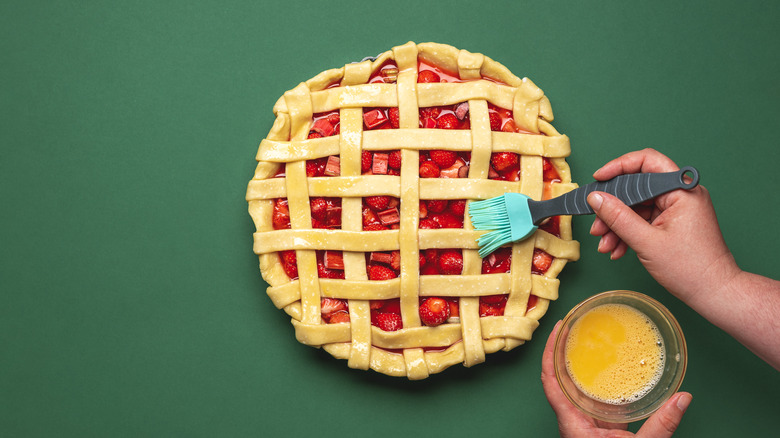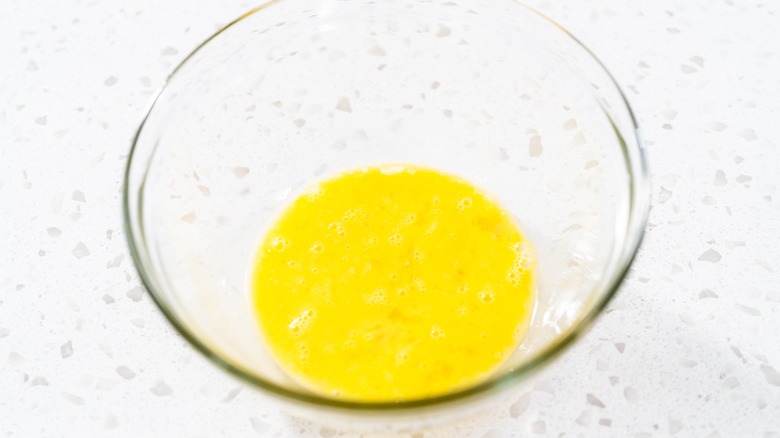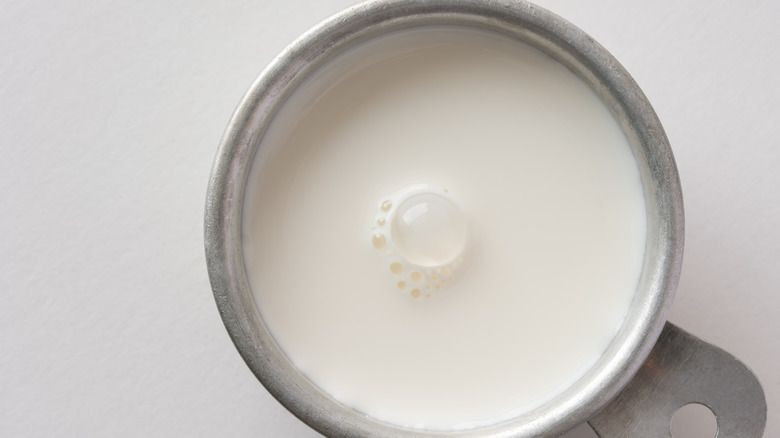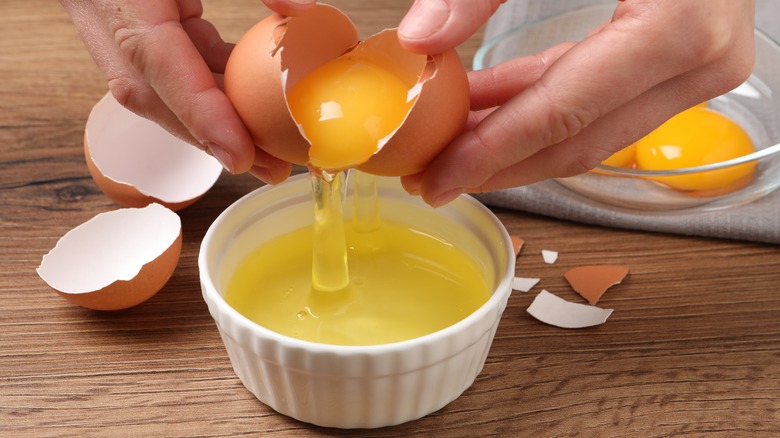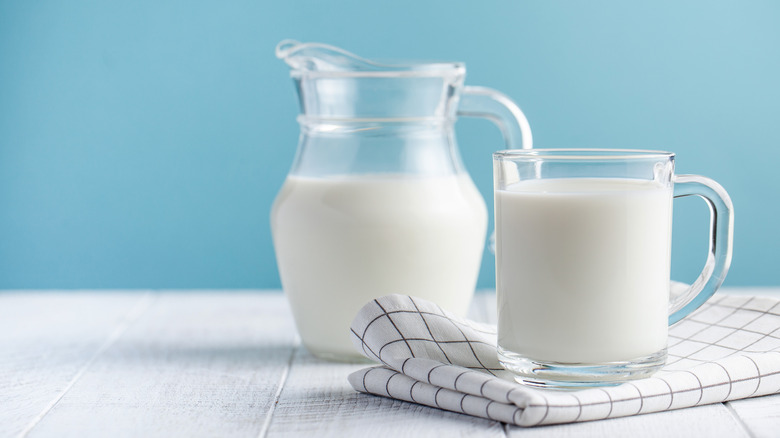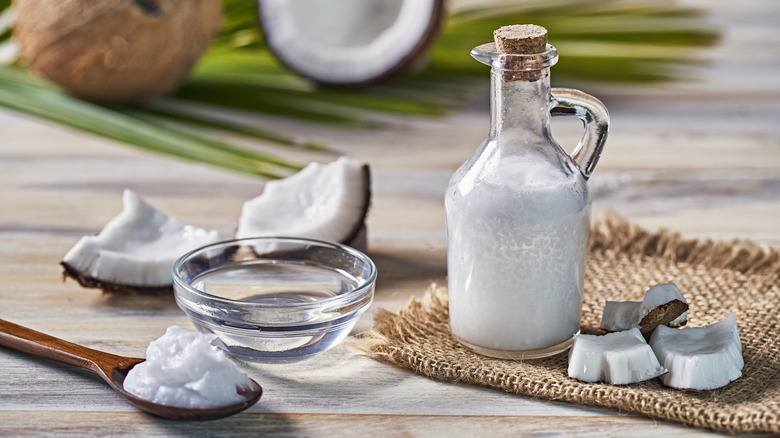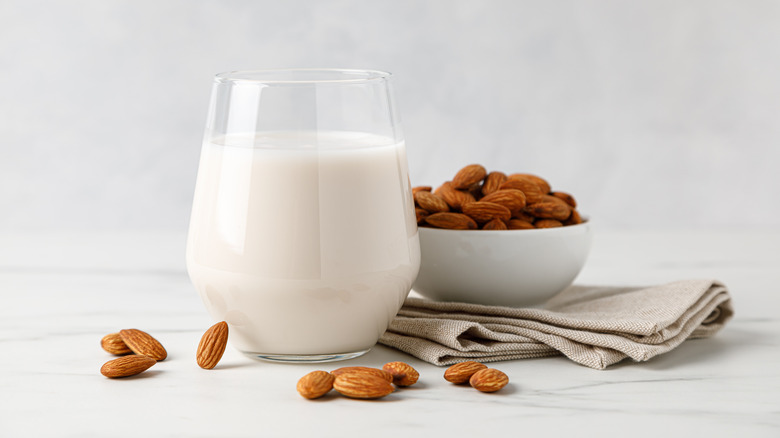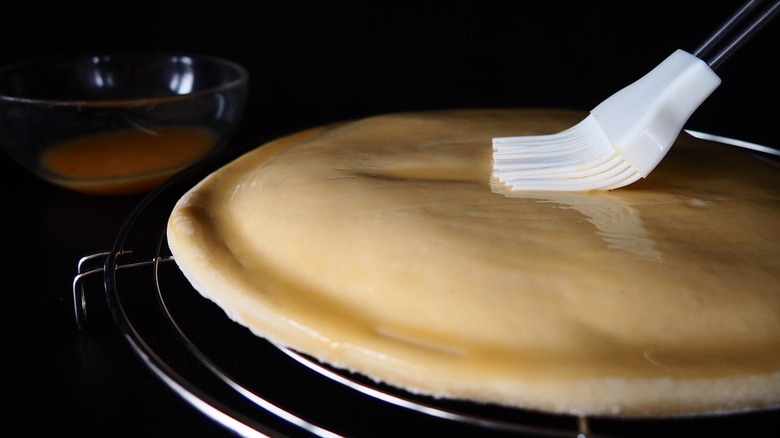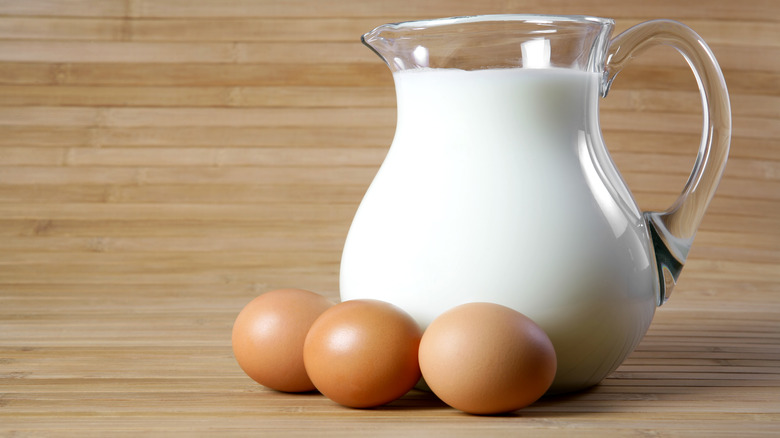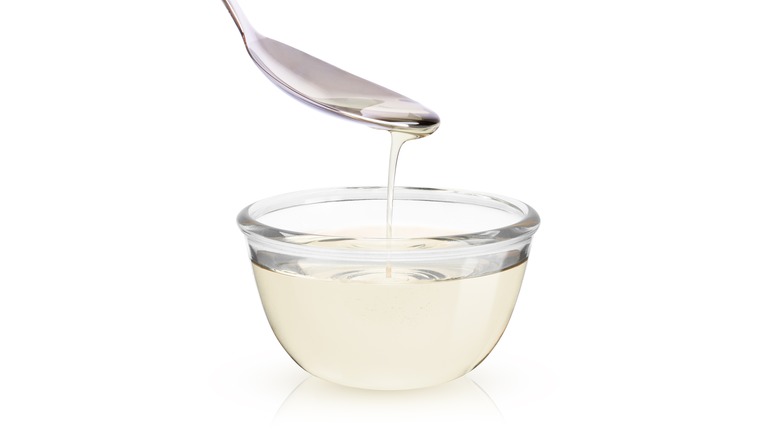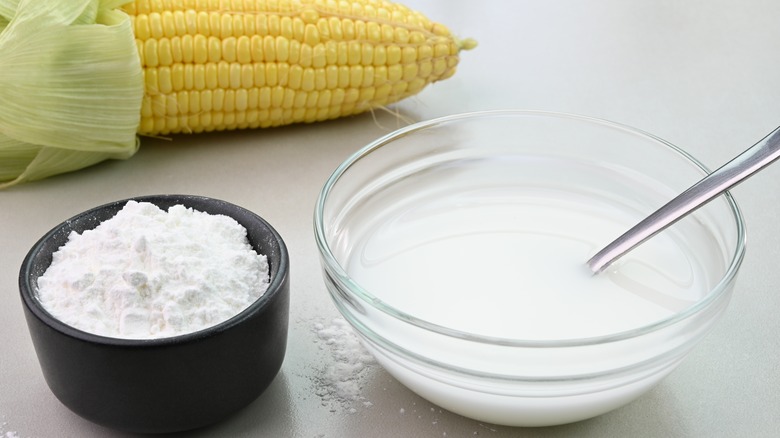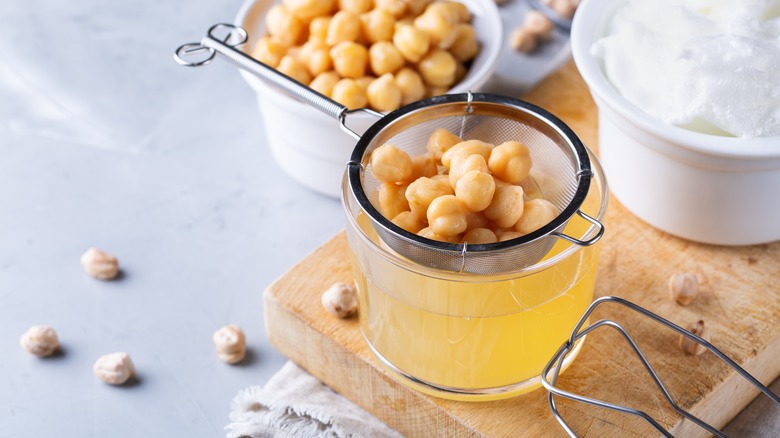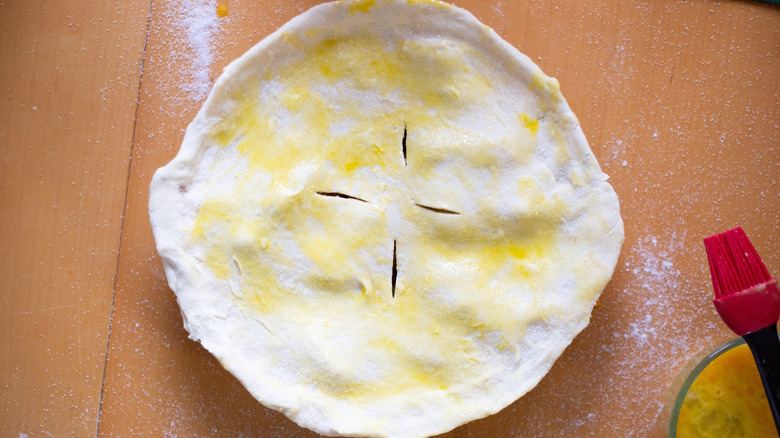12 Types Of Pie Crust Washes And How They Affect Your Dough
The difference between a good pie and a great one is often in the wash. A pie crust wash, the solution that you daub over the top of your pastry before putting it in the oven, has several functions. The most obvious one is improving the color. A pie crust wash provides a golden, glossy, or browned sheen to your pies and makes them look more appetizing. They also help to stick parts of your pie together, and can be an adhesive for artistic flourishes or scatterings of seeds or sugar. As well as this, they can intensify the flavor of your pie's surface slightly, and add a little crispiness. Pie crust washes, though, are not one-size-fits-all.
While most people are familiar with the concept of an egg wash, there are loads of ingredients, from coconut oil to aquafaba, that can improve the texture and visual appearance of your pie. Additionally, egg washes themselves vary considerably, with different recipes containing water, milk, and even sugar, which can produce varying effects. With our comprehensive guide to different pie crust washes, you'll never have to guess what they'll do to your pastry again.
1. Whole egg and water
The traditional combination of whole beaten eggs and water is one of the most popular pie crust washes, and for good reason: It requires nothing more than a simple ingredient that you'll likely have on hand, a dash of H2O, and a quick whizz with a fork. It also provides one of the most reliable results when baked. A combo of egg and water will give your pastry a golden-brown shade and a gently glossy effect and will help to lightly crisp the outside of your pie. Its relatively neutral flavor, meanwhile, means that it can be used for both sweet and savory options.
Whole egg and water is the ideal choice if you're looking for a noticeable color change, but don't want things to get too dark. As it's lower in fat and protein than a whole egg and milk or whole egg and cream combo, it won't produce a super-deep color. Bear in mind that the addition of water can thin it out slightly, and as such it may not adhere to pastry quite as well as a combination of egg and cream might, but in all honesty, the impact will be pretty minimal.
2. Heavy cream
Using heavy cream as a pie crust wash is an easy and reliable choice. This wash takes minimal preparation, requiring little more than the removal of the lid from a heavy cream carton. Its intense dairy flavor gives your pastries a slightly creamy taste. Heavy cream is best used on dough that doesn't expand when it's baked so that the color can set in and the coating doesn't crack.
Heavy cream washes give the pastry a lightly golden effect that shines well. The coloring is developed by the protein and sugar content, which, when heated, usher in the Maillard reaction, altering and deepening its shade. The shininess is provided by the high fat content of the cream, which also gives it a thickness that makes it easy to spread onto the pastry. What you lose when you use a heavy cream wash, though, is the deep-yellow shade that egg washes provide. Eggs have substantially more protein than heavy cream does, and as such the Maillard reaction is even more pronounced, with the yellow tone of beaten whole eggs providing a base coat of color for the browning to occur.
3. Egg white
Want to keep things simple? Go for egg whites. Egg white washes excel in their shininess, and can give your pie crusts a serious lustre. This effect is even more obvious when you beat your egg whites vigorously, making them frothy before painting them onto your pie's surface. Whipping them well also prevents any stringy pieces from making their way onto your food.
However, there's one thing you won't get a lot of when using egg whites: color. When compared to using whole eggs or milk, egg whites barely change the color of the pastry at all, so it may not be the best option if you're looking to noticeably alter your pie's shade. Instead, we would recommend using egg whites on pastries that already have some coloring to them (like chocolate-infused pastry, for example). Egg white is also a great choice if you're planning on topping your pastries or pies with sugar or seeds, as it'll allow the topping to pop and shine without distracting with deeper tones. Egg white is also great as a binder, and is one of the best choices to adhere your pie lid to the bottom crust.
4. Whole milk
If you don't have any eggs left after making your pie, whole milk is a great choice. Whole milk has a pretty good protein and fat content, and when combined with the milk's natural lactose sugars, you'll end up with a coating that's lightly glossy and a mid-brown shade. Whole milk's neutral taste also means that it can be used on a lot of different pastries without the risk of altering the flavor too significantly.
Bear in mind, though, that whole milk can sometimes produce a slightly yellow tone, instead of the golden-brown effect that egg washes provide. As such, it's probably best for pastries that have a little color already, so your pie doesn't end up looking too anemic. We would also advise using whole milk wherever possible, rather than skim or low-fat options. These choices still have protein and sugar in them, which can give them a little bit of color, but the lack of fat will prevent any significant change to their shade, and it's not much different from just adding water to your pie crust.
5. Coconut oil
Vegans, rejoice! Not all pie crust washes are dairy or egg-based, and coconut oil is one of the best plant-based options out there. Coconut oil is pure fat, and this fat creates a serious brownness on your pastry's edge that's on par with an egg wash. Because coconut oil is pretty much flavorless, it can be used on both sweet and savory pastries.
What you do lose when you use coconut oil, unfortunately, is shininess, as the fat helps to brown but not buff your pastry. Additionally, it's worth remembering that coconut oil is solid at room temperature, so you'll have an extra preparation step on your hands here, having to melt it slightly before brushing it onto the pastry. You may also find that you have to watch your pastry more closely when using coconut oil. As this option is pure fat, you run a higher risk of cooking the outside of your pie too much, and if left unmonitored it can turn from brown to burnt quite quickly. It's best to just use a very light coating of coconut oil, ensuring that it's evenly spread to avoid any brown spots.
6. Almond milk
If you're following a plant-based diet, almond milk is a great substitute for whole milk as a pie crust wash. Almond milk can give your pie crust a subtle hint of nuttiness and a light change in color, browning the surface slightly. Sweetened almond milk is likely more effective than unsweetened when it comes to browning, as the sugars in the recipe will help to develop color on your crust, while also giving your pastry a little sweetness.
It's important to remember that this sweetness won't always be welcome. If you're making a savory pie, you may wish to use a different plant-based wash, like coconut oil or aquafaba. Because almond milk is low-fat, you also shouldn't expect too much color change here, and it doesn't quite compare to the effects provided by high-fat eggs or dairy. Almond milk can also be slightly uneven when it comes to browning, and certain spots can develop in color more than others. Because it's so thin, we would recommend using a good-quality dense-bristled pastry brush, which can catch all of the liquid and distribute it evenly.
7. Egg yolk
To create excellent color and shine on your pastries, all you need is an egg yolk. Although egg washes are usually a combination of eggs and a liquid, omitting extra ingredients and using just the yolk is both possible and worthwhile. Egg yolks contain the vast majority of fat in an egg, and a lot of its protein. Both of these ingredients help to create gloss and a deep golden brown color on the pastry, and when they're not diluted with other ingredients, the effect is even more intense.
One thing to bear in mind with egg yolk washes is that they can be pretty thick, making painting it onto pastry and getting full coverage slightly more tricky. If you don't beat the egg yolk fully, this can also lead to an unevenness in your coating. Remember, too, that egg yolks might not go as far as you think, and you might need to use a couple beaten together to fully coat your pie crust. Think about what you can do with your leftover egg whites, too, so that you're not throwing them away and contributing to food waste.
8. Egg and milk
One of the most common pie crust washes, an egg-and-milk combo, is also one of the most effective. Whole beaten eggs with a dash of milk will produce a mid-brown effect for your dough, with a light glossiness to boot. The milk helps to thin the eggs out slightly, making your wash easier to spread and more workable into the nooks and crannies. The brownness won't be quite as deep as if you're using a higher-fat liquid like cream, nor will it be as glossy, but it'll still be noticeably different. The more fat content your milk has, though, the more gloss you'll get.
A combo of eggs and milk can also make a great sealant for your pastry pieces, acting as a glue to keep your top and bottom crust together. Because the flavor of eggs and milk is pretty unassuming, you can use it for both sweet and savory pastries, and as an adhesive for any herb, spice, or sugar toppings. Because an egg-and-milk solution won't brown things too intensely, we would advise using it on pastry that you want to develop slightly, but still have its original shade stay intact.
9. Water-sugar solution
A mixture of water and sugar is amongst the most basic pie crust washes available, and it's something that almost every chef can whip up. However, don't mistake its simplicity for ineffectiveness. Water and sugar can have a powerful browning effect on pie crusts, thanks to the lack of any other ingredients, leaving the sugar at liberty to provide color without being neutralized. You can either use granulated sugar dissolved into water, or powdered sugar and hot water to make more of a glaze-like coating.
Unfortunately, though, the high sugar content also makes it more prone to burning your crusts, and you may find that your pastry darkens too much, with the sugar becoming bitter. As such, we'd only recommend using a water-sugar solution if you're out of other options, or if you're intentionally trying to provide deep color to pastry — and even then, you should watch your pie like a hawk while it's in the oven. It's also important to remember that water-sugar combos will flavor pastry more noticeably than other pie crust washes and give them sweetness. This makes them largely unsuitable for savory pies.
10. Cornstarch
It might seem strange to coat a doughy, starchy food item with another form of starch, but with cornstarch, it's worth it. Cornstarch is often used as part of batters or in slurry form to give fried food items a crispy coating. When used as a pie crust wash, it can provide your pastry with a slightly crispy exterior, while also making it super glossy. As it doesn't have to be mixed with eggs or dairy to have a glossing effect, it's great for vegan or plant-based baking. It's also particularly effective as a binder for your food.
It's worth noting that a cornstarch coating won't develop your pastry's color too much, so it's especially good for dyed or colored pastries, or simply showing off your pie's natural paleness. Thickness is an important factor with cornstarch. Although you do need it to be thick enough to cling to your pastry properly, if you make it too thick (or paint it on too generously), it will make the outside of your food gummy. Make sure that it resembles a thin, milky liquid when mixed, and not a thick slurry.
11. Aquafaba
Next time you go to drain your chickpea water down the sink, save it for your next baking session instead. Aquafaba (which means "bean water") is the cloudy liquid leftover in your can of chickpeas, which absorbs some of the proteins and starches from the legumes it helps to preserve. Aquafaba has long been used as a vegan substitute for egg whites, thanks to its ability to foam and firm up when whipped. Its similarity to egg whites also makes it a great substitute in egg washes.
When applied as an egg wash, aquafaba provides a surprising amount of brownness, even more than other plant-based alternatives like coconut oil or almond milk. The lack of fat holds it back from creating a deep-brown gloss, but the color and effect even more by adding in a plant-based fat like coconut or avocado oil. Aquafaba takes barely any preparation, either — you just have to retain it from your chickpea can, and daub it on. Importantly, aquafaba has a very subtle flavor, so you needn't worry too much about your baked goods tasting like chickpeas. It also makes it suitable for flavored pastries, allowing the taste of your bake to shine through.
12. Egg and sugar
Adding a combo of egg and sugar to the outside of your pie crust will produce big results. Whipping eggs and sugar, with or without the addition of milk, cream, or water to loosen up the mixture, gives you a mixture of fat, proteins, and sugars, which create a golden-brown color and glossiness. The added sugar gives a caramelization effect to proceedings, deepening the shade and heightening the shine even more.
This caramelization can be made even more pronounced if you're combining your eggs and sugar with milk, which has a natural sugar content. With this mixture, however, you need to be pretty careful. It's a very fine line between caramelization and burning, and if you add too much sugar, you risk ruining your pastry, as well as making its outside way too sweet. We would therefore recommend just adding a pinch or two in to intensify the desired effects, or else cutting the mixture with water to slightly temper it. Adding some water will also make your solution easier to spread, and will help your sugar dissolve, so you're not left with any stray granules burning on your pie crust.
